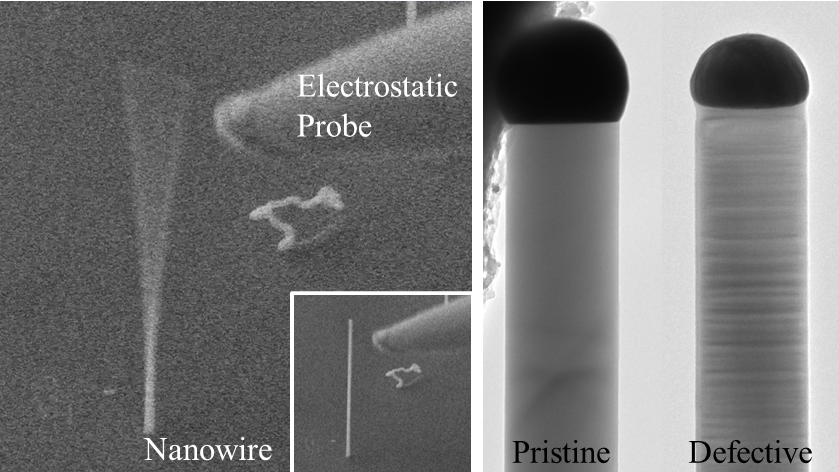Publications
Filter by type:
Toward Patient Specific Models of Pediatric IVDs: A Parametric Study of IVD Mechanical Properties
Patient specific finite element (FE) modeling of the pediatric spine is an important challenge which offers to revolutionize the treatment of pediatric spinal pathologies, for example adolescent idiopathic scoliosis (AIS). In particular, modeling of the intervertebral disc (IVD) is a unique challenge due to its structural and mechanical complexity. This is compounded by limited ability to non-invasively interrogate key mechanical parameters of a patient’s IVD. In this work, we seek to better understand the link between mechanical properties and mechanical behavior of patient specific FE models of the pediatric lumbar spine. A parametric study of IVD parameter was conducted, coupled with insights from current knowledge of the pediatric IVD. In particular, the combined effects of parameters was investigated. Recommendations are made toward areas of importance in patient specific FE modeling of the pediatric IVD. In particular, collagen fiber bundles of the IVD are found to dominate IVD mechanical behavior and are thus recommended as an area of primary focus for patient specific FE models. In addition, areas requiring further experimental research are identified. This work provides a valuable building block toward the development of patient specific models of the pediatric spine.
Soot particle morphology and nanostructure with oxygenated fuels: A comparative study into cold-start and hot-start operation
This study investigates the morphology and nanostructure of soot particles during cold-start and hot-start engine operation of a diesel engine using oxygenated fuels. The soot samples were analysed using transmission electron microscopy. The oxygen content in the fuel was varied between 0 and 12%. The results showed that the primary particles during cold-start have significantly smaller size when compared to hot-start engine operation. The addition of oxygenated fuels also resulted in smaller sized primary particles. Smaller radius of gyration and higher fractal dimension of soot aggregates during cold-start would mean smaller aggregate size with a more compact structure. Shorter fringes with a higher inter-fringe spacing for cold-start would mean lower graphitisation of soot particles that could be related to higher oxidation reactivity of soot particles.
Estimation of load conditions and strain distribution for in vivo murine tibia compression loading using experimentally informed finite element models
The murine tibia compression model, is the gold standard for studying bone adaptation due to mechanical loading in vivo. Currently, a key limitation of the experimental protocol and associated finite element (FE) models is that the exact load transfer, and consequently the loading conditions on the tibial plateau, is unknown. Often in FE models, load is applied to the tibial plateau based on inferences from micro-computed tomography (μCT). Experimental models often use a single strain gauge to assess the three-dimensional (3D) loading state. However, a single strain gauge is insufficient to validate such FE models. To address this challenge, we develop an experimentally calibrated method for identifying the load application region on the tibial plateau based upon measurements from three strain gauges. To achieve this, axial compression was conducted on mouse tibiae (n=3), with strains gauges on three surfaces. FE simulations were performed to compute the strains at the gauge locations as a function of a variable load location. By minimising the error between experimental and FE strains, the precise load location was identified; this was found to vary between tibia specimens. It was further shown that commonly used FE loading conditions, found in literature, did not replicate the experimental strain distribution, highlighting the importance of load calibration. This work provides critical insights into how load is transferred to the tibial plateau. Importantly, this work develops an experimentally informed technique for loading the tibial plateau in FE models.
Stress distribution in the mouse-tibia loading model using analytical approaches together with correction factors
INTRODUCTION:
The mouse-tibia compression model (MTCM), is the gold standard for studying bone adaptation due to mechanical loading in vivo [1]. Often, experiments are replicated in silico through finite element (FE) modelling, providing insights into the link between adaption and localised loading (i.e. stress and strain) [2]. However, FE models of the MTCM are rather complex and computationally expensive. An alternative is to use analytical models (i.e. continuum mechanics) [3]. However, the latter assume the fibula is negligible, thus overestimating tibial load. This work explores the validity of this assumption and proposes correction factors for the use of analytical models.
MATERIALS AND METHODS:
The tibia of a 16 week, female, C57BL/6 mouse was digitised via micro computed tomography (Skyscan 1172, 19 m voxel size). Both FE and analytical models were studied. The tibia was pin supported about the inferior articular surface. Load on the tibial head was represented by a point load at a given (x,y) location, 87 different load locations were investigated. For the FE model (ANSYS 19.2) a direct voxel to element meshing was used. For the analytical model, continuum-mechanics based beam equations were used (the fibula was neglected). An elastic modulus of 17 GPa and 10 GPa was used for bone and growth-plates respectively.
RESULTS & DISCUSSION
Figure 1 shows the proportion of load carried by the tibia, for different load locations. Studies suggest that in the MTCM, load is applied to the posterior edge of the condyles, thus approximately 88% of the load can be expected to be carried by the tibia. Comparison of the FE and analytical models shows error in the maximum axial stress to exceed 20% at the expected load location. Assuming skeletal similarity across C57BL/6 strain, we propose the load proportions from Figure 1 can be used as a general correction factor for the axial load in the analytical model. Through this correction factor, this error can be reduced below 10% at the expected load location.
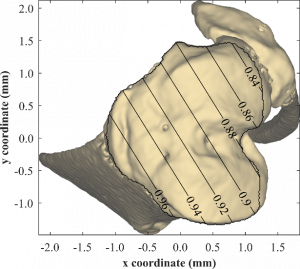
Figure 1: Proportion of load within the tibia for a given (x,y) load location.
CONCLUSION
Analytical models of the MTCM neglect the fibula. Dependent upon load location, it was found the fibula carries approximately 12% of the load, this can create sizable errors in the predicted stresses in the tibia. By correcting for the total load in the tibia, this error can be minimized.
REFERENCES
[1] A. Robling and C.H. Turner, Annu. Rev. Biomed. Eng., Vol. 8, pp. 455498, 2006.
[2] Sugiyama, et al., Bone, 43(2), 238–248, 2008.
[3] Wagner, et al., Journal of Biomechanics, 46(13), 2271–2276, 2013.
Characterisation on the hygrothermal degradation in the mechanical property of structural adhesive: A novel meso-scale approach
Structural adhesives are being increasingly used for bonding of dissimilar materials, however environmental degradation remains a significant challenge limiting the bonding reliability. A common form of degradation comes from water ingress, regarding which there is limited quantitative understanding of how water diffusion affects the adhesive local mechanical properties. This work proposes a meso-scale approach to characterise the influence of water diffusion on local mechanical properties of structural adhesives at elevated temperature, aiming to develop a model of degradation due to water exposure. Gravimetric study was conducted on adhesives immersed in deionised and 5 wt% NaCl water, to obtain water diffusion characteristics. The immersed specimens were periodically removed from the aqueous environment and precisely cut to expose the internal section. The samples were then indented using nanoindentation to extract the modulus and hardness distribution. SEM observation was conducted to analyse the microscopic morphology and ageing mechanism. Experimental results revealed that water diffusion caused significant local (meso-scale) degradation in adhesive mechanical properties. Increase in local moisture concentration led to greater degradation as moisture gradually diffused inward. Comparing to salt water immersion, the elastic modulus and hardness of adhesive saturated in deionised water decreased by further 5.9% and 11.9%, respectively. The developed degradation model coupled with insights from ageing mechanism provides a detailed understanding of degradation in adhesive property due to water diffusion. The proposed characterisation approach can be readily applied to other adhesives. Furthermore, this model allows for degradation of such adhesives to be reasonably predicted through FE modelling effort.
Where is the load applied in the mouse-tibia model? Insights through finite element modelling.
INTRODUCTION: The mouse-tibia loading model [1] has become the gold standard for investigating bone adaption and is a powerful tool in the exploration of interventions aimed at osteoporosis. In this, an in vivo loading regime is mechanically applied to the mouse tibia. Localised adaption of the cortical and trabecula bone can be measured. Often, this is replicated in silico through finite element modelling (FEM), providing deeper insights into the link between adaption and localised stresses and strain (a key component of Frost’s mechanostat [2]).
However, the FEM approach is problematic, as its predictions are highly dependent on how load is applied to the tibia. Differences in loading can results in large differences in the predictions of the FEM model. While some studies [3] have investigated this, the question of the where load is applied in the mouse-tibia model remains an open question. In this work, we seek to answer this question by investigating the relationship between load location and strain, comparing against experimental values.
METHODS: Female C57BL mice were used. Prior to experimentation, micro-CT slices were recorded. Following micro-CT, strain gauges were attached to the medial and lateral surface of the tibial diaphseal mid-shaft, proximal to the junction with the fibula, in line with the method used by De Souza [1]. The lower leg was mounted in a loading apparatus with the ankle and knee securely held by two cups. Loads were applied, up to 10 N, and the results strain gauge readings were recorded.
Using the micro-CT slices, the 3D geometry of the tibia was reconstructed through an in-house code. The volume was meshed through a direct voxel meshing approach where each voxel was transformed into an eight-node brick element. Nodes of the distal end were fixed. While the physiological loading at the proximal end is complex, it can be simplified to a single load at a representative location. A 10 N load was applied to the proximal end at selected coordinates. The load position was varied to quantify the relation between load location and strain measured at gauge locations. This is described in Figure 1a.
RESULTS AND DISCUSSION: The FEM modelling showed that the strains at each gauge location were highly dependent on the load location. This is significant as it demonstrates that failure to correctly identify the load location will results in erroneous prediction. To demonstrate this, Figure 1b-c shows the differing strain predictions for two different load locations.
This can be extended by modelling the gamut of potential load locations. In doing so, the effective load location can be ascertained, being the location with the minimum deviation between experimental and FEM strain values. This requires strain readings from a minimum of two gauges.
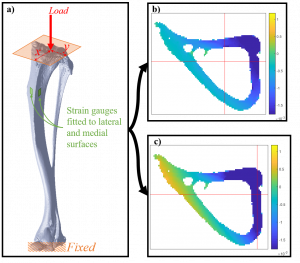
Figure 1: a) Schematic of the FEM model showing the variable load location, b-c) example strain predictions for two different load location (red cross-hair is a projection of the load location).
CONCLUSIONS: FEM modelling, coupled with in vivo data from two strain gauges can be used to determine the load location in the mouse-tibia loading model. Our results show that failure to correctly identify the load location will lead to erroneous results. We recommend that future works incorporate this technique to ensure valid predictions.
REFERENCES
- De Souza, R. L., et al, Bone, 37(6), 810–818.
- Frost, H. M, Anatomical Record – Part A Discoveries in Molecular, Cellular, and Evolutionary Biology, 275(2), 1081–1101.
- Poulet, B., et al., Arthritis and Rheumatism, 63(1), 137–147.
The super-element, stiffness-matrix approach to interrogate 3D intervertebral disc mechanics
INTRODUCTION
Finite element (FE) models of intervertebral discs (IVD) are inherently complex, requiring multiple tissue parameters to be defined for tissues which can be difficult to characterise experimentally. Due to this complexity, understanding how each parameter combines to produce the overall mechanics of the IVD is challenging. To overcome these challenges we used the super-element approach to provide a novel means of interrogating the IVD mechanics. Of particular interest in the current study, was the coupled, three dimensional (3D) mechanical response of the lumbar spine IVD and to what extent the 3D IVD stiffness is reliant upon the collagen fibre network.
METHODS
A physiologically realistic FE model of the L1-L2 IVD was developed. Geometry of the IVD represented the NIH Visible Human Project, Visible Man. Figure 1 shows the geometry and mesh of the IVD. The nucleus pulposus was modelled using 3D hydrostatic fluid elements, the annulus fibrosis ground matrix with 3D solid continuum elements, and the collagen fibres with tension only rebar elements. The rebar elements were embedded at ±30° to the transverse plane of endplates, to represent the alternatively angled collagen fibre network. Collagen fibre spacing and cross-sectional area was based on [2]. The annulus fibrosis was treated as a Mooney-Rivlin hyperelastic material ( MPa, MPa) and the collagen fibres as linear-elastic (tension only, MPa). Further details of the FE modelling can be found in [1]. Nodes representative of the superior and inferior end plates where constrained to a single node located at the centre of the respective end plate (referred to as control nodes).
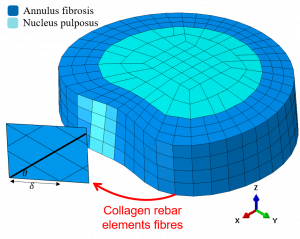
Figure 1: FE model of the IVD showing the annulus (with collagen fibre angle) and nucleus mesh.
In the super-element approach, degrees of freedom (DOF) of the FE model’s stiffness matrix are decomposed, retaining only the desired DOF. Here, a super element was constructed, retaining only the DOF of the control nodes. In this sense, the FE stiffness matrix can be simplified to a stiffness matrix in terms of just the loads and displacements acting on the superior and inferior surfaces of the IVD.
To explore the power of this approach, a parametric study was conducted to determine the influence of model parameters on the IVD behaviour. This provides a very effective way of elucidating the contribution of each individual component. Three parameters were investigated; collagen fibre stiffness (250 to 500 MPa), collagen fibre angles (15° to 60°), and ground matrix stiffness (0.35 to 0.7 MPa).
RESULTS AND DISCUSSION
Through the results of the parametric study, it was demonstrated how the super-element, stiffness-matrix approach is a powerful tool for interrogating the IVD mechanics. The study further demonstrates how the stiffness matrix can be visualised, providing a powerful technique for understanding the complex coupled motions of the IVD. The parametric study were able to identify several key model features: (i) collagen fibre stiffness plays a significant role in transverse stiffness, but play a lesser role in axial stiffness; (ii) a clear coupling between axial and transverse motion was observed, which was not significantly affected by fibre stiffness; and (iii) collagen fibre angle has a significant effect on IVD stiffness in all directions and on motion coupling.
CONCLUSIONS
The super-element stiffness matrix approach allows direct extraction of the underlying stiffness matrix which is advantageous in exploring the complex 3D behaviour of the IVD. This method of stiffness matrix extraction has several direct applications including as inputs for musculoskeletal modelling, benchmarking for artificial IVDs, and providing a powerful tool for exploring the complex 3D behaviour of the IVD. This approach can be effectively extended to analyse other tissue behaviour, such as the functional spinal unit.
REFERENCE
- J Little, Computer Methods in Biomechanics and Biomedical Engineering, 11, 95-103, 2008
- Marchand, F, Ahmed, A., Spine, 15(5), 412, 1990.
The impact of chemical composition of oxygenated fuels on morphology and nanostructure of soot particles
Over the years, oxygenated fuels such as biodiesel and alcohol fuels have been useful in reducing particulate matter (PM) emissions of diesel engines. The presence of oxygen in the fuel impacts the soot oxidation process and thus the morphology and nanostructural characteristics of soot particles change. The nanostructure characteristics of soot particles hold an importance for their oxidation reactivity and toxicity. Higher reactivity and exposure of soot particles to oxygen will affect the regeneration and filtration efficiency of diesel particulate filters. In this study, we investigate the impact of oxygen functional groups on morphology and nanostructure of soot particles by blending different types of essential oil in diesel. The test fuels were prepared by mixing orange oil, tea tree oil, eucalyptus oil and coconut biodiesel to keep an overall oxygen content of 0 and 2.2%. Transmission electron microscopy was used to investigate the physical changes in the nanostructure of soot particles. The primary particle diameter decreases, and fractal dimension of soot aggregates increases for oxygenated fuels. Microscopy reveals that the arrangement of carbon lamellae within the soot particles changes significantly with use of oxygenated as observed by the changes in fringe length, fringe tortuosity and fringe separation distance. Lower fringe length, higher fringe tortuosity and fringe separation distance shows disordered arrangement of carbon layers with more possibility of oxygen attack. The different structural characteristics for oils having same oxygen content shows that formation and structure of soot particles strongly depend upon chemical structure and composition of the fuel.
Influence of fuel-oxygen content on morphology and nanostructure of soot particles
The share of biofuels in the fuel market has increased over the last several decades. This is related to their potential to reduce the emissions including particulate matter. It has been frequently reported that the fuel oxygen content is the main reason for the reduction in particulate matter emissions. To understand the effect of fuel oxygen content on morphology and nanostructure characteristics of soot particles, different fuels such as diesel, coconut biodiesel and triacetin were tested in a diesel engine with various mixing proportions. The fuel blending was done in such a way that overall oxygen content of fuel was kept in range of 0% to 14% (wt.%). The soot particles were sampled from the engine exhaust system and analysed with a transmission electron microscope (TEM) at low and high spatial resolution. The TEM images were post-processed with the help of an in-house developed image analysis program to determine the morphology and nanostructure characteristics. The results show that oxygenated fuel blends emit smaller sized soot particles forming compact aggregates. The investigation of the internal structure of soot particles show disordered arrangement of graphene layers for fuels up to 11.01% fuel oxygen content (pure biodiesel); however, the opposite trend was observed for fuel blends with triacetin which could be related to the presence of oxygen in a different chemical functional group.
How Gaseous Environment Influences a Carbon Nanotube-Based Mechanical Resonator
Nanoscale mechanical resonator-based nanoelectromechanical systems have been reported with ultrahigh sensitivity, which are normally acquired from an ultravacuum environment at cryostat temperature. To facilitate their practical applications for gas sensing or bio-detection, it is critical to understand how the fluid (gas or liquid) environment will impact the resonance behaviors of the nanoresonator. This work reports a first-time comprehensive investigation on the influence of the N2 gaseous environment on the resonance properties of carbon nanotube (CNT)-based mechanical resonator, through a combination of grand canonical Monte Carlo and large-scale molecular dynamics simulations. It is shown that the gaseous environment exerts a significant effect on the resonance properties of the CNT resonator through a dynamic desorption and readsorption process. Under the temperature of 100 K and the pressure of 1 bar, the displacement amplitude of the CNT resonator is found to experience a sharp reduction of about 82% within the first 90 ps vibration in the N2 gaseous environment. Further, a large initial excitation is found to result in smaller adsorption and a reduced damping effect. For instance, when the excitation velocity amplitude increases from 2 to 8 Å/ps, the damping ratio shows more than 40% reduction. It is found that higher pressure leads to a smaller resonance frequency and enhanced damping effect, while higher temperature induces an increase in the resonance frequency but a decrease in the damping ratio. This work shows that the gaseous environment has a marked impact on the vibrational properties of nanoresonators, which should shed light on the application of mechanical nanoresonators in a fluid environment.
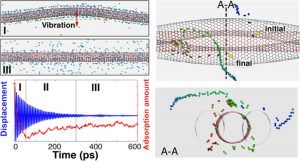
Experimental Analysis of the Morphology and Nanostructure of Soot Particles for Butanol/Diesel Blends at Different Engine Operating Modes
In order to comply with strict emission standards, a reduction in diesel particle matter emissions can be addressed by minimizing particle formation and by optimizing particle oxidation in the combustion chamber and in the exhaust and diesel particulate filter systems. The characterization of soot morphology and nanostructure is necessary to understand the soot formation and oxidation processes. Furthermore, understanding these characteristics is important because they affect the aerodynamic behavior of diesel particulate matter in the exhaust system, diesel particulate filter systems, and the environment. This study aims to investigate the influence of fuel oxygen content and engine operating modes on the morphology and nanostructure of soot particles. The oxygen content in the fuel was varied from 0% to 4.32% and 6.48% by using diesel and 20 and 30% butanol blends (by volume) with diesel. As the oxygen content increased, corresponding nanostructure characteristics fringe length and separation distance increased and fringe tortuosity decreased. Changes to the nanostructure properties will have an influence on the operation of diesel particle filters, particularly during the regeneration processes. However, other characteristics such as the influence of these fuels on particle mass and number emissions, performance parameters, and gaseous emissions will also have a significant influence on implementing these fuels in modern diesel vehicles.
Comparison of manual and automatic approaches for characterisation of morphology and nanostructure of soot particles
Highlights
- The manual and automatic approaches for analysis of the morphology and nanostructure of soot particles are compared.
- Fast Fourier transform (FFT) is applied for calculation of fringe separation distance.
- The comparison between manual and automated approaches showed similar results with better accuracy.
Abstract
This study is an attempt to compare the manual and automatic approaches for analysis of the morphology and nanostructure of soot particles. The automated methodology is composed of two parts: soot particle analysis (morphology characterisation) and soot fringe analysis (nanostructure characterisation) such as fringe length, fringe tortuosity and fringe separation distance. In this study the application of Fast Fourier Transform (FFT) is introduced, which omits the manual selection of fringe pairs for measurement of fringe separation distance and aids fast computation. The parameters which effect the performance of automated approach were identified and optimised. The automated approach was applied to analyse images from different fuels. Using the optimised parameters, the performance of the automatic approach was tested against results obtained by the manual approach. The statistical comparison between two approaches showed similar results but with better accuracy for automated approach (lower standard error) and thus validates the functionality of the proposed methodology. The application of FFT in computation of fringe separation distance reduces the computation time and avoids biases of operator in selecting fringe pairs.
Steered molecular dynamics characterization of the elastic modulus and deformation mechanisms of single natural tropocollagen molecules
Abstract
Collagen is a common structural protein, providing mechanical integrity for various vertebrate connective tissues such as cartilage and bone. The mechanical behaviours of these tissues under physical stimulations are controlled by the hierarchical structure of collagen and its interactions with other extracellular matrix molecules. However, the mechanical properties and deformation mechanisms of natural collagen under physiological loading rates at the molecular level are not fully understood. In this study, comprehensive steered molecular dynamics (SMD) simulations were performed on the 2nd intact overlap region (d2ol) and the 2nd intact D-period (d2olgp) of an in-situ characterized collagen molecule, under a large range of strain rates (6.5 × 106% s−1 to 1.3 × 1012% s−1). The results show that, depending on the applied strain rates, tropocollagen molecules unfold in different ways. Particularly, at high and intermediate strain rates, the number of inter-chain hydrogen bonds decreases rapidly even at small deformations, leading to a dramatic increase in the force. This results in an increase in the estimated Young’s modulus of collagen triple helices as the deformation rate goes up, which, together with the nonlinear mechanical behaviour, explains the broad range of the Young’s modulus for collagen model peptides reported in earlier SMD studies. Atomistic-level analyses indicate that the elastic modulus of single tropocollagen molecules decreases as the strain rate becomes smaller. However, for strain rates below 1.3 × 108% s−1, the tangent Young’s modulus of d2ol (d2olgp) converges to approximately 3.2 GPa (3.4 GPa), at the strain of 10.5% (12%) when the segment is fully uncrimped. Furthermore, for strain rates under 1.3 × 108% s−1, d2ol and d2olgp show identical deformation mechanisms (unwinding, uncoiling and backbone stretching), but the corresponding strain ranges are different. This study will aid in future studies on characterizing the mechanical properties of collagen molecules and collagen-like peptides by indicating the proper pulling strain rates and how to determine the suitable strain range used for evaluating the elastic modulus.

Shortened abstract:
This thesis uses the mechanical resonance technique to investigate and characterise the mechanical behaviour of nanowires. While previous work has mainly focused on simple, uniform nanowires, this thesis extends the resonance technique to incorporate more complex morphologies. Specifically, tapered nanowires with surface effects and curved nanowires with irregular cross-sections were investigated through experiments and modelling. This works will aid in advancing the pace of nanowire development by extending the resonance technique to describe such nanowire morphologies.
In situ mechanical resonance behaviour of pristine and defective zinc blende GaAs nanowires
Abstract
The structural versatility of semiconducting gallium arsenide (GaAs) nanowires (NWs) provides an exciting direction for the engineering of their mechanical and dynamic properties. However, the dynamic behaviour of GaAs NWs remains unexplored. In this study, comprehensive in situ mechanical resonance tests were conducted to explore the dynamic behaviour of pristine and defective zinc blende GaAs NWs. The effects of stacking faults (SFs), amorphous shell, NW tapering and end-mass particles were investigated. The quality factors (QFs) of the GaAs NWs were found to be predominately governed by surface effects, which increased linearly with the volume to surface area ratio. Interestingly, SFs were found not to influence the QFs. To extract the mechanical properties, the Euler–Bernoulli beam theory was modified, to incorporate the core–shell model, NW tapering and end-mass particles. It was found that the core–shell model accurately predicts the mechanical properties of the pristine GaAs NWs, which exhibit significant stiffening at radii below 50 nm. Conversely, the mechanical properties of the defective NWs were influenced by the presence of SFs, causing a wide variance in the Young’s modulus. Apart from establishing an understanding of the resonance behaviour of GaAs NWs, this research provides guidance for the design of NWs for their applications in dynamic nanomechanical devices with tailorable dynamic properties.
Impact of fuel oxygen on morphology and nanostructure of soot particles from a diesel engine
Diesel engines are often preferred over gasoline engines because of their fuel efficiency and reliability; however, there are significant issues around their environmental pollution which is controlled by emission regulations. To meet the ever more stringent regulations, reduction in diesel particle matter emissions can be addressed by minimising particle formation and by optimising particle oxidation in the combustion chamber and in the exhaust and diesel particulate filter systems. Soot formation and oxidation processes are the predecessors to the hysicochemical properties of diesel particulate matter and are characterised by morphology and nanostructure. These characteristics principally include primary particle size, fractal dimension, fringe length, fringe tortuosity and fringe separation distance. Thus, understanding of these characteristics is necessary for an efficient reduction of particle emissions from diesel engines. Furthermore, understanding these characteristics is important because they affect the aerodynamic behaviour of the diesel particulate matter in the exhaust system, diesel particulate filter systems, and the environment. This study aims to investigate the impact of butanol on morphology and nanostructure of soot particles from a 5.9 L turbocharged diesel engine at different engine loads. The oxygen content in the fuel was varied from 0% to 4.32% and 6.48% by using diesel, 20 and 30 % of butanol blends with diesel (Bu0, Bu20 and Bu30). The results indicate that the oxygenated fuels made by blending with butanol had a significant impact on the aerodynamic behaviour of soot particles. This could result in different lung deposition patterns and therefore different toxicity, as well as the change in the diesel particle filters’ filtration efficiency. As oxygen content increased, the corresponding nano-structural characteristics of fringe length and separation distance increased,
whereas fringe tortuosity decreased. The change of the nanostructure properties will further influence the diesel particle filters through the changes in the regeneration processes, and will therefore have a significant influence on implementing these fuels in modern diesel vehicles.
Atypical defect motions in brittle layered sodium titanate nanowires
Abstract
In situ tensile tests show atypical defect motions in the brittle Na2Ti3O7 (NTO) nanowire (NW) within the elastic deformation range. After brittle fracture, elastic recovery of the NTO NW is followed by reversible motion of the defects in a time-dependent manner. An in situ cyclic loading–unloading test shows that these mobile defects shift back and forth along the NW in accordance with the loading–unloading cycles and eventually restore their initial positions after the load is completely removed. The existence of the defects within the NTO NWs and their motions does not lead to plastic deformation of the NW. The atypical defect motion is speculated to be the result of the glidibility of the TiO6 layers, where weakly bonded cation layers are in between. Exploration of the above novel observation can establish new understandings of the deformation behavior of superlattice nanostructures.
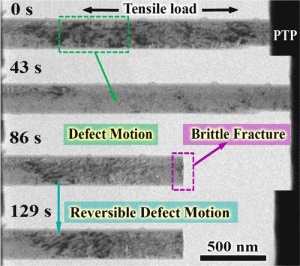
Worked example videos as a valuable blended learning resource in undergraduate engineering units
Abstract
Context
Within many maths-heavy (MH) undergraduate engineering units (UEU), teaching teams rely on written worked-solution documents to assist students in bridging the gap between tutorials and self-directed study. However, these are limited in their usefulness as they are a passive medium and poor at communicating the ‘why’ required for deeper understanding. Alternatively, worked-example videos (WEVs) involve an instructor demonstrating a solution while discussing the underlying strategies being employed. The audio-visual medium encourages increased interaction with the content, promoting cognitive processing and improving the quality of student learning. Limited studies have investigated the potential for WEVs as high-quality blended learning resources in UEU. Better understanding of WEV impact could lead to their widespread use in the blended learning transformation.
Purpose
To explore the impact of WEVs in MH-UEU by investigating student-video usage, interaction, and attitude, and the resultant effect on perceived academic performance.
Approach
WEVs were produced weekly for two MH-UEU at the Queensland University of Technology. Student engagement, perceived academic performance and attitude toward the WEVs were evaluated using a mixed methods approach incorporating viewership data and an end-of-semester survey. The study comprised 1,713 students across five cohorts over three semesters.
Results
Students engaged significantly with the WEVs with almost 24,500 views and 89 days of continuous viewing time across the five cohorts. Exam preparation was the dominant motivator for WEV usage. Approximately 90% of students used an active learning style when interacting with the WEVs, with many taking advantage of video controls like pausing, skipping and rewinding. This enabled students to work alongside the WEVs, using them to provide hints and verify solution processes, as well as concentrate on specific sections of the WEVs, thus individualising their learning to focus on areas they found challenging. The majority of students agreed WEVs improved their knowledge of the unit content, had the potential to improve their grades, and would be useful in other similar units.
Conclusions
WEVs are a valuable blended learning tool, capable of empowering student learning and enabling deeper engagement with problem solving tasks. Student interactions with the WEVs suggest that they are well-suited to MH-UEU where worked examples are an important learning tool.

